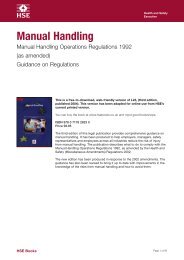Making Companies Safe - what works? (CCA ... - Unite the Union
Making Companies Safe - what works? (CCA ... - Unite the Union
Making Companies Safe - what works? (CCA ... - Unite the Union
Create successful ePaper yourself
Turn your PDF publications into a flip-book with our unique Google optimized e-Paper software.
Gray and Scholz attempt to understand <strong>the</strong> large specific deterrent impact that <strong>the</strong>y found in<br />
<strong>the</strong> following terms. They argue that OSHA penalties act as a ‘wake-up call’ by refocusing<br />
managerial attention on safety and health problems that may have been overlooked. They<br />
also speculate that:<br />
“The initial focus on specific OSHA violations, though perhaps annoying to busy<br />
managers, triggers a broader review of performance that we suspect goes far<br />
beyond a legalistic response to OSHA standards.” 35<br />
And this is true even where <strong>the</strong> costs of <strong>the</strong>se efforts may outweigh any future expected<br />
penalty. 36<br />
This is consistent with Hopkin’s study which reports that senior managers of large companies<br />
were normally unaware of visits by occupational safety and health inspectors when such visits<br />
did not result in any formal notices. 37 However, <strong>the</strong>y did become aware of adverse inspection<br />
reports when <strong>the</strong>ir companies were issued on-<strong>the</strong>-spot fines or some o<strong>the</strong>r formal penalty.<br />
Similarly, Baldwin and Anderson’s survey of executives of large UK companies found that 71<br />
per cent of companies that experienced a punitive sanction reported that:<br />
“such sanctioning had impacted very strongly on <strong>the</strong>ir approach to regulatory<br />
risks… For many companies, <strong>the</strong> imposition of a first sanction produced a sea<br />
change in attitudes”. 38<br />
Whilst <strong>the</strong> US data just discussed demonstrates a general deterrent effect, this effect is small<br />
relative to <strong>the</strong> specific deterrent effect, possibly due to <strong>the</strong> fact that <strong>the</strong> chances of inspection<br />
and detection of non-compliance are low. Never<strong>the</strong>less, <strong>the</strong>re is o<strong>the</strong>r evidence to suggest<br />
that general deterrence ‘<strong>works</strong>’. For instance, after reviewing <strong>the</strong> empirical studies from <strong>the</strong><br />
US and Canada, Brown notes that:<br />
“There is good reason to believe that penalties enhance compliance in <strong>the</strong> short<br />
term by threatening would be offenders with punishment, and in <strong>the</strong> long term<br />
by changing attitudes about <strong>what</strong> is morally acceptable behaviour.” 39<br />
Specific evidence for this is cited by Gunningham and Johnstone who note that:<br />
“The State of Oregon increased its OHS penalties threefold from 1987 to 1992,<br />
toge<strong>the</strong>r with o<strong>the</strong>r changes to its enforcement, prevention, and workers<br />
compensation programmes, and found that workers’ compensation claims fell by<br />
over 30% and fatalities by over 21% from 1988 to 1992, even though<br />
employment increased by 10%. The incidence of lost workday cases fell by over<br />
21% from 1988 to 1991.” 40<br />
In this country, Baldwin and Anderson report in relation to <strong>the</strong>ir survey of top UK executives,<br />
that 57 per cent of respondents indicated that sanctions against o<strong>the</strong>r companies had<br />
‘impacted <strong>the</strong>ir own management of risks “very strongly”. 41 There is also evidence to suggest<br />
that employers are:<br />
“affected by <strong>the</strong> cumulative effect of numerous prosecutions against o<strong>the</strong>r<br />
companies and by hearing of <strong>the</strong> imposition of very large penalties or<br />
jail sentences.” 42<br />
In relation to <strong>the</strong> general deterrent effect of inspections, investigations and prosecutions,<br />
Gunningham considers whe<strong>the</strong>r <strong>the</strong> deterrent values of prosecution could increase in <strong>the</strong><br />
event of a substantially increased likelihood of detection coupled with an increased penalty –<br />
or with <strong>the</strong> deployment of more effective penalties than fines. He concludes, on <strong>the</strong> basis of<br />
empirical studies from <strong>the</strong> US, Canada and Australia, that an increase in both <strong>the</strong> severity and<br />
certainty of punishment would increase <strong>the</strong> general deterrent effects of inspection and<br />
prosecution, though <strong>the</strong>re is evidence that certainty of punishment exerts a stronger influence<br />
than severity of punishment. 43 In relation to this last point, however, Johnstone warns that<br />
this does not mean that <strong>the</strong> size of <strong>the</strong> penalty has no impact on compliance. Instead he<br />
argues that penalties which are too low may have little condemnatory force and may<br />
<strong>the</strong>reby reduce <strong>the</strong> deterrent effect of <strong>the</strong> law. 44 45
















